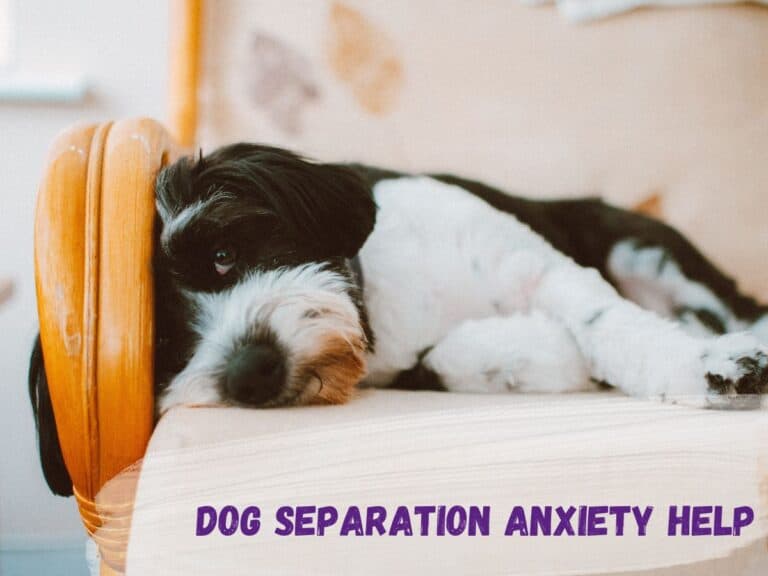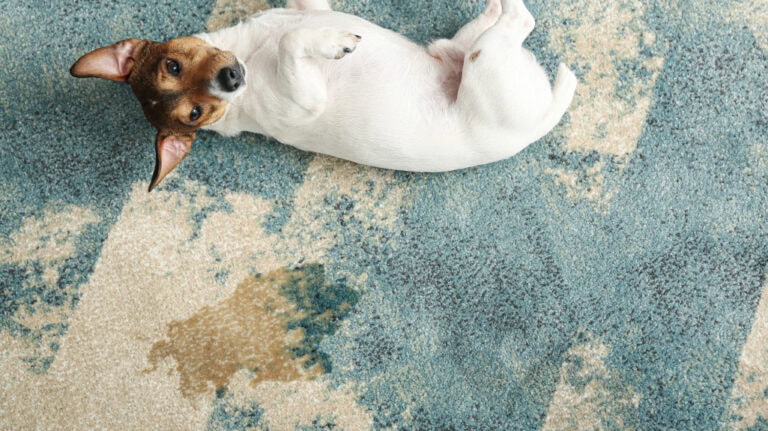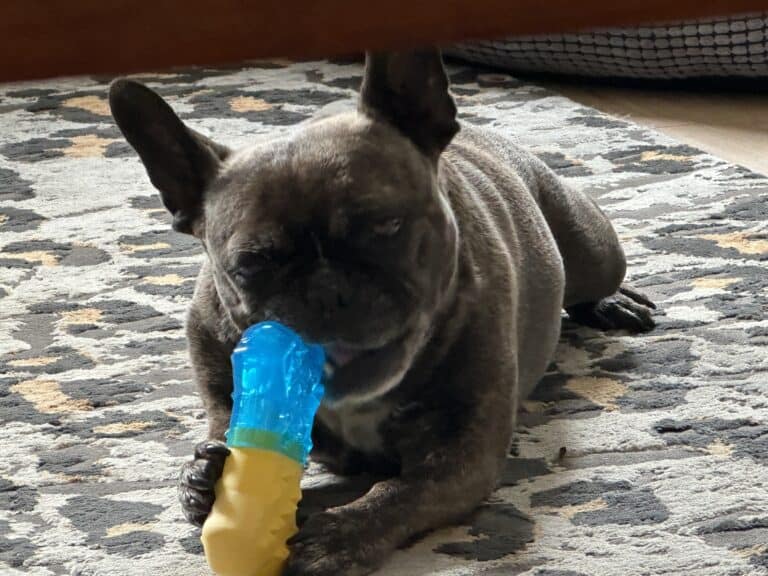Working From Home With a Separation-Anxious Dog: Practical Tips
The Pet Coach features affiliate links and participates in the Amazon Services LLC Associates Program. If you choose to make a purchase through one of these Amazon links, I may earn a small commission—at no additional cost to you. These affiliate earnings help support the website and allow me to continue providing free content for pet parents. For more details, please see my disclosure policy.
You’ve likely noticed your dog’s anxious behaviours intensify since you started working from home—the constant following, whimpering when you step away, or destructive tendencies during brief absences. While your presence should theoretically comfort them, separation anxiety often worsens when dogs become overly dependent on your constant availability. Research shows that without proper boundaries and training, remote work can actually escalate these issues. However, you can transform this challenge into an opportunity to build your dog’s confidence and independence.
Understanding Separation Anxiety Symptoms in Dogs
When your dog exhibits distress behaviours in your absence, they’re likely experiencing separation anxiety—a condition that affects millions of dogs worldwide.
You’ll notice symptoms like excessive barking, howling, or destructive chewing when you leave for errands or appointments. Your house-trained dog might have indoor accidents, pace continuously, or drool excessively. Some dogs attempt to escape, scratching at doors or windows in search of their owners.
Working from home, separation anxiety dog cases often worsen when you suddenly return to office schedules after extended periods together.
A pet camera helps you identify specific triggers and monitor behaviour patterns. Watch for panting, whimpering, or furniture destruction that occurs shortly after your departure. Desensitisation training is a valuable method to help your dog gradually adjust to being alone.
Recognising these symptoms early prevents escalation into more severe behavioural issues requiring intensive intervention.
Creating a Structured Daily Routine
Creating a structured daily routine forms the foundation for helping your separation anxious dog feel secure and predictable in their environment.
You’ll need to establish consistent times for feeding, walks, and play while gradually incorporating short separation periods that mirror your work schedule.
Managing how you handle departures and arrivals becomes essential, as these changes often trigger the most intense anxiety responses in dogs struggling with separation issues. Implementing a pre-departure routine can help ease your dog’s anxiety during these transitions.
Establishing a Consistent Daily Schedule
Since dogs thrive on predictability, establishing a consistent daily schedule becomes one of your most powerful tools for managing separation anxiety while working from home. Set specific times for meals, walks, and play sessions to create a framework your dog can rely on. This predictability reduces anxiety by helping your pet understand what to expect throughout the day.
Gradually adjust your routine to align with your work-from-home hours, teaching your dog when you’ll be available and when they need to be independent.
Include structured exercise, bathroom breaks, and mental stimulation in your schedule to prevent boredom and stress. Consider using timers or visual cues to signal changes, which helps your dog anticipate adjustments and reduces uncertainty-driven anxiety behaviours.
Managing Departure and Arrival
Building on your established routine, how you handle departures and arrivals greatly impacts your dog’s emotional state and overall progress with separation anxiety.
Keep your greetings and farewells low-key by using simple phrases like “I’ll see you soon, be good,” rather than dramatic goodbyes that heighten stress. Avoid showing excessive emotion during these changes, as heightened energy can worsen your dog’s anxiety.
Before leaving, ensure your dog is exercised, fed, and has had bathroom breaks. This creates a comfortable environment during your absence and reduces restless behaviour.
Gradually increase your time away to help your dog acclimatise to separation. Start with brief departures and slowly extend the duration, reinforcing the routine that prepares them for your absence while building their confidence in your return.
Establishing an Independent Workspace
Your workspace setup plays an essential role in managing your dog’s separation anxiety while maintaining productivity.
By creating clear physical boundaries and implementing systematic separation training, you’ll help your dog understand when it’s work time versus interaction time.
These strategies work together to reduce your dog’s dependence on constant attention while building their confidence during independent periods. Additionally, focusing on evidence-based approaches can enhance the effectiveness of your training efforts.
Creating Physical Work Boundaries
When you work from home with a separation anxious dog, establishing clear physical boundaries becomes essential for both your productivity and your pet’s emotional well-being.
Designate a specific area in your home as your workspace to create clear separation between work and your dog’s space. Use baby gates or closed doors to restrict access while allowing your dog to feel secure in their designated area.
Introduce this setup gradually, letting your dog explore the workspace when you’re not working to reduce anxiety about the changes.
Place a comfortable dog bed or crate nearby but separate from your workspace, giving your pet a cosy retreat that promotes independence.
Practice short separation periods in different rooms, gradually increasing duration as your dog becomes more comfortable with these established boundaries.
Gradual Separation Training Methods
Once you’ve established your physical workspace boundaries, implementing gradual separation training becomes the cornerstone of helping your anxious dog develop independence.
Start with brief 15-30 minute intervals in your designated workspace, allowing your dog to acclimatise without overwhelming them. Gradually extend these periods as they demonstrate calm behaviour.
Use positive reinforcement consistently—reward quiet, relaxed responses during separations to build their confidence over time.
Place mentally stimulating toys or puzzle feeders in their area to redirect anxious energy into productive activities.
Practice multiple short separations throughout your workday rather than one extended period.
This systematic approach helps your dog understand that your workspace time is temporary and predictable, reducing their anxiety while fostering the independence necessary for successful remote work arrangements.
Gradual Separation Training Techniques
Building your dog’s tolerance to alone time requires a methodical approach that starts with separations lasting just a few minutes.
You’ll gradually increase the duration by 5 to 10 minutes as your dog demonstrates comfort with being alone. This systematic progression prevents overwhelming your anxious pet.
Use positive reinforcement throughout the process—reward calm behaviour with treats or praise to create positive associations with solitude.
A pet camera becomes invaluable for monitoring your dog’s stress responses during your absence, allowing you to identify specific triggers and adjust your training accordingly.
Establish consistent daily routines including regular feeding, walks, and playtime to build security.
Create a designated safe space equipped with familiar toys and comfort items, transforming alone time into a reassuring experience rather than a source of anxiety. Additionally, consider seeking help from local pet care services that can provide professional support for your dog’s needs during longer absences.
Mental Stimulation and Enrichment Activities
While your separation anxious dog learns to tolerate alone time, mental stimulation becomes a powerful tool for redirecting their focus and reducing stress.
Puzzle toys requiring problem-solving skills keep dogs engaged for extended periods, markedly reducing anxiety through sustained mental engagement.
Interactive toys like KONGs filled with treats or peanut butter encourage independent play, which is crucial for anxious dogs.
During separations, scatter dry food or use food-dispensing toys to occupy their attention while engaging natural foraging instincts.
Regular training sessions teaching new tricks stimulate your dog’s brain and promote self-confidence, helping alleviate anxiety.
Scent work activities, such as hiding treats around the house, provide mental enrichment and satisfying challenges that reduce boredom and loneliness during your absence. Additionally, incorporating behavioural modification techniques can enhance the effectiveness of these activities in managing separation anxiety.
Building Your Dog’s Confidence and Independence
Beyond keeping your dog’s mind occupied, fostering genuine confidence and independence requires a structured approach that gradually expands their comfort zone.
Start with brief 15-30 minute separations, allowing your dog to build trust in their ability to be alone. Create a safe haven using a cosy crate or designated area where they’ll feel secure during your absence.
Establish consistent routines for feeding, walking, and playtime—predictability reduces anxiety and builds confidence naturally.
When leaving or returning home, use positive reinforcement to reward calm behaviour rather than making a fuss. This teaches your dog that departures and arrivals are normal events, not emotional crises.
These incremental steps help your dog develop genuine self-sufficiency while you work from home. Additionally, consider utilising data storage techniques to track your dog’s progress and adjust your training plan accordingly.
When to Seek Professional Help
Though building independence takes time, certain warning signs indicate your dog needs professional intervention beyond what home training can provide. If your dog exhibits severe destructive behaviours, constant vocalisation, or self-harm like excessive licking and chewing, it’s time to seek help from a veterinary surgeon or certified dog trainer.
Consider professional consultation when your home methods haven’t been effective despite consistent effort. A pet behaviourist can provide tailored strategies specifically designed for your dog’s anxiety patterns.
Similarly, trainers experienced in separation anxiety can implement structured training plans while offering you essential support throughout the adjustment process.
Don’t hesitate to reach out if anxiety symptoms persist despite routine adjustments and independence-promoting activities. Professional intervention prevents physical harm and accelerates your dog’s progress toward emotional stability.
Conclusion
You’ve learned evidence-based strategies to support your separation anxious dog while maintaining work productivity. Remember, progress takes time and patience—don’t expect overnight changes. Consistency with your routine, gradual training, and mental enrichment will build your dog’s confidence over time. Monitor their responses and adjust techniques as needed. If anxiety persists despite your efforts, don’t hesitate to consult a veterinary behaviourist. You’re equipped to create a calmer, more balanced home environment for both of you.




